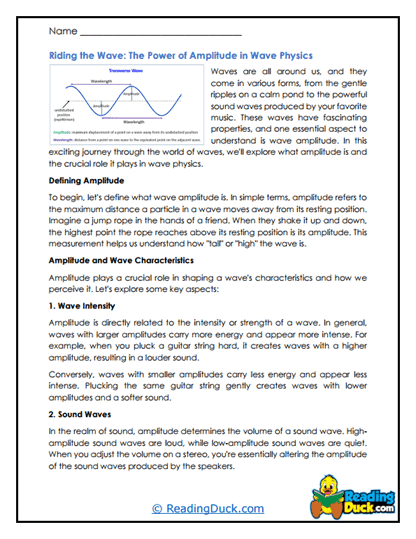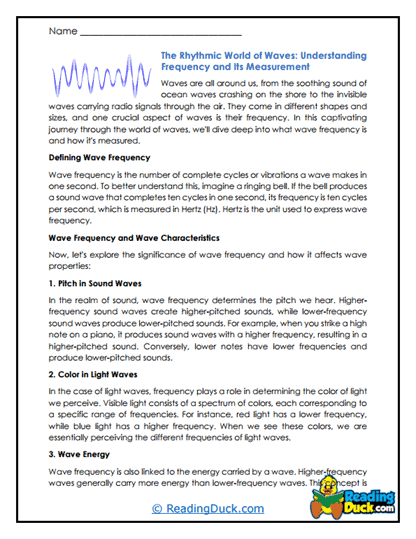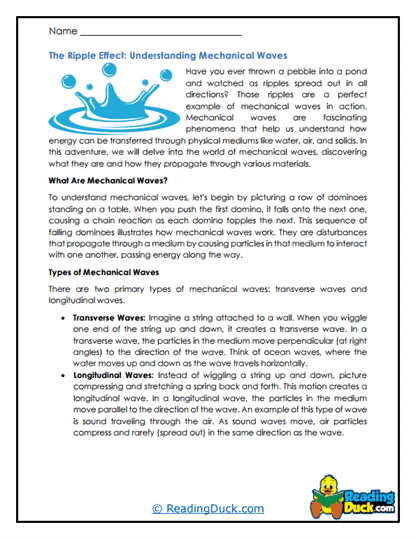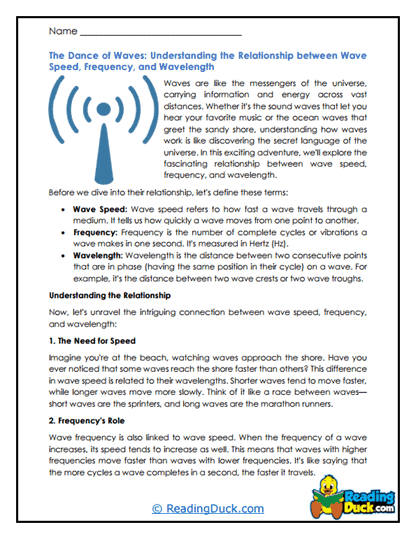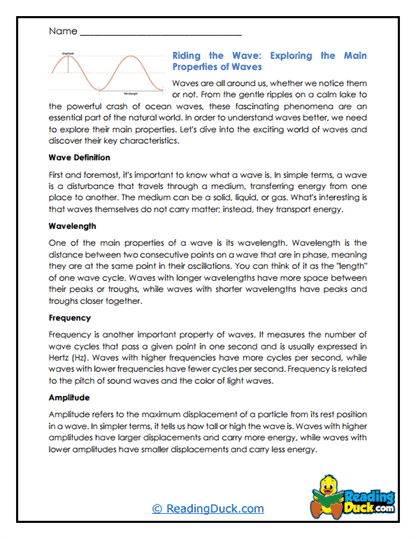Waves Worksheets
About Our Waves Worksheets
Our Waves worksheets provide a comprehensive and engaging exploration of the fundamental concepts of wave phenomena in Physics. This collection is designed to help students understand the nature of waves, their properties, and their applications in various fields of science and technology. Each worksheet set is carefully crafted to enhance students' understanding through reading passages, comprehension questions, and interactive activities.
Each worksheet set includes:
- Multiple Choice Questions: These questions assess students' grasp of core wave concepts such as frequency, wavelength, amplitude, and wave types. These questions are designed to reinforce the key ideas and provide a quick check for comprehension.
- Short Answer Questions: These prompts require students to explain concepts in their own words, allowing them to demonstrate their understanding and develop their ability to articulate complex ideas clearly.
- Open-Ended Questions: These questions encourage critical thinking and creativity, asking students to apply their knowledge to real-world scenarios, explore the implications of wave phenomena, and express their personal opinions or preferences related to the topic.
An answer key is provided for each question sheet, making it easy for teachers and parents to guide students through the material. All worksheets are available as PDF files, which can be easily viewed electronically, downloaded, and printed for use in various educational settings.
Understanding Waves: The Backbone of Sound, Light, and Communication
The Nature of Waves
Waves are disturbances that transfer energy from one place to another without transferring matter. They are fundamental to many processes in nature and technology, making them an essential topic in Physics. Waves can travel through different mediums, such as air, water, and even vacuum, depending on the type of wave.
Key Concepts in Waves
- Types of Waves:
- Mechanical Waves: These waves require a medium to travel through, such as sound waves traveling through air or water waves moving across the ocean. Mechanical waves can be further classified into transverse waves, where the wave oscillates perpendicular to the direction of propagation, and longitudinal waves, where the oscillation is parallel to the direction of propagation.
- Electromagnetic Waves: Unlike mechanical waves, electromagnetic waves do not require a medium and can travel through a vacuum. These include light waves, radio waves, and X-rays, all of which play critical roles in communication, medicine, and technology.
- Wave Properties:
- Wavelength: The distance between two consecutive points in phase on a wave, such as crest to crest or trough to trough. Wavelength is a critical factor in determining the wave's behavior and its interactions with other waves.
- Frequency: The number of waves that pass a given point per second, measured in Hertz (Hz). Frequency is inversely related to wavelength and directly affects the energy of the wave.
- Amplitude: The height of the wave from its rest position to its crest or trough. Amplitude is related to the energy of the wave, with larger amplitudes indicating more energy.
- Speed: The speed at which a wave travels through a medium, which can be calculated using the wave equation v=fλv = f \lambda, where vv is the wave speed, ff is the frequency, and λ\lambda is the wavelength.
Applications of Waves in Everyday Life
Waves are integral to many aspects of our daily lives, from the sound of music to the light that enables us to see. Understanding waves allows students to appreciate the science behind technologies they use every day.
Waves in Communication and Technology
- Radio Waves and Microwaves: These electromagnetic waves are used in various communication technologies, such as radio broadcasting, television, and mobile phones. By understanding how these waves are generated and transmitted, students can gain insights into how information is sent and received across vast distances.
- Fiber Optics: Light waves are used in fiber optic cables to transmit data at incredibly high speeds over long distances. This technology is the backbone of the internet, making the study of light waves essential for understanding modern communication systems.
Waves in Medicine
- Ultrasound: Sound waves with frequencies higher than the human hearing range are used in medical imaging to create pictures of the inside of the body. Understanding how these waves interact with different tissues helps explain how doctors can diagnose conditions without invasive procedures.
- X-Rays: Electromagnetic waves with very short wavelengths are used to view the inside of the body, particularly bones. The study of these waves' properties helps students understand how they can penetrate different materials and provide vital medical information.
Waves in Nature
- Seismic Waves: These are mechanical waves generated by earthquakes. By studying seismic waves, students can understand how energy travels through the Earth and how this knowledge is used to study the Earth's interior and predict natural disasters.
- Ocean Waves: The study of ocean waves helps explain coastal processes and the impact of waves on erosion, navigation, and marine life. Understanding wave dynamics is crucial for environmental science and marine engineering.
Activities to Supplement These Worksheets
To deepen students' understanding of waves and make learning more interactive and engaging, here are some activities that teachers and parents can use to supplement these worksheets:
1. Create a Wave Model
- Objective: Visualize wave properties such as wavelength, frequency, and amplitude.
- Activity: Students can use a slinky or a rope to create wave models. By varying the speed and direction of the slinky or rope, they can observe how changes in wavelength and frequency affect the wave's behavior. This hands-on activity helps students relate abstract concepts to physical phenomena.
2. Investigate Sound Waves
- Objective: Explore the properties of sound waves and how they interact with different materials.
- Activity: Provide students with tuning forks, a stethoscope, or a speaker and a microphone. They can experiment with how sound waves travel through different materials like air, water, and solids. By measuring how sound changes when it passes through these materials, students can better understand sound wave propagation and reflection.
3. Explore Electromagnetic Waves
- Objective: Understand the different types of electromagnetic waves and their uses.
- Activity: Assign students to research various electromagnetic waves (radio waves, microwaves, infrared, visible light, ultraviolet, X-rays, and gamma rays). They can create a poster or digital presentation that explains each type of wave, its wavelength and frequency, and its applications in daily life. This project helps students appreciate the wide range of electromagnetic waves and their importance in technology and science.
4. Simulate Ocean Waves
- Objective: Understand the formation and behavior of ocean waves.
- Activity: Students can create a wave tank using a large container filled with water. By generating waves in the tank with a paddle or by blowing across the water's surface, they can observe how waves are formed, how they interact with obstacles, and how they break. This activity can be extended by exploring how wave energy is transferred to the shore, impacting erosion and sediment transport.
5. Analyze Seismic Waves
- Objective: Understand how seismic waves provide information about the Earth's interior.
- Activity: Students can simulate an earthquake using a shake table and measure how seismic waves travel through different materials, such as sand, clay, or rock. By recording how the waves propagate and change speed, they can infer the properties of the materials they pass through. This experiment links the study of waves to geology and natural disaster preparedness.
6. Investigate Light Waves with Prisms
- Objective: Understand the behavior of light waves when passing through different media.
- Activity: Provide students with a prism and a flashlight. They can observe how white light splits into a spectrum of colors when it passes through the prism. Students can experiment with changing the angle of the light source and the prism to see how it affects the spectrum. This hands-on activity helps students explore the properties of light waves, including refraction and dispersion.
Significance of Studying Waves
Studying waves is fundamental to understanding many natural phenomena and the principles behind countless technologies that shape our world. Waves are the carriers of energy and information, from the sound we hear to the light we see and the signals that power our communication devices. By mastering the concepts of waves, students gain a deeper appreciation of the physical world and develop critical thinking skills that are essential in science and engineering. Furthermore, understanding waves opens up possibilities for future exploration in fields like acoustics, optics, telecommunications, and environmental science. This knowledge not only enhances students' scientific literacy but also prepares them for careers that rely on a solid foundation in Physics.
